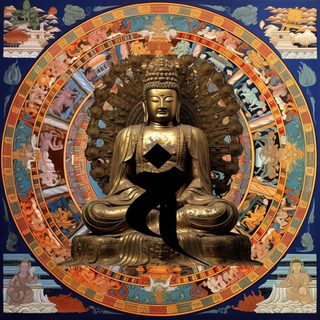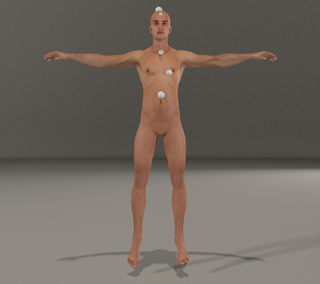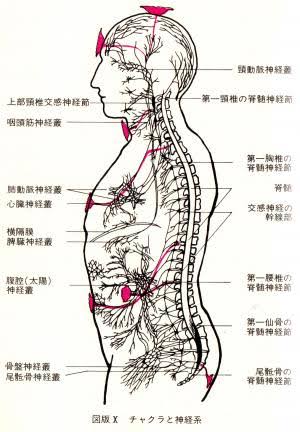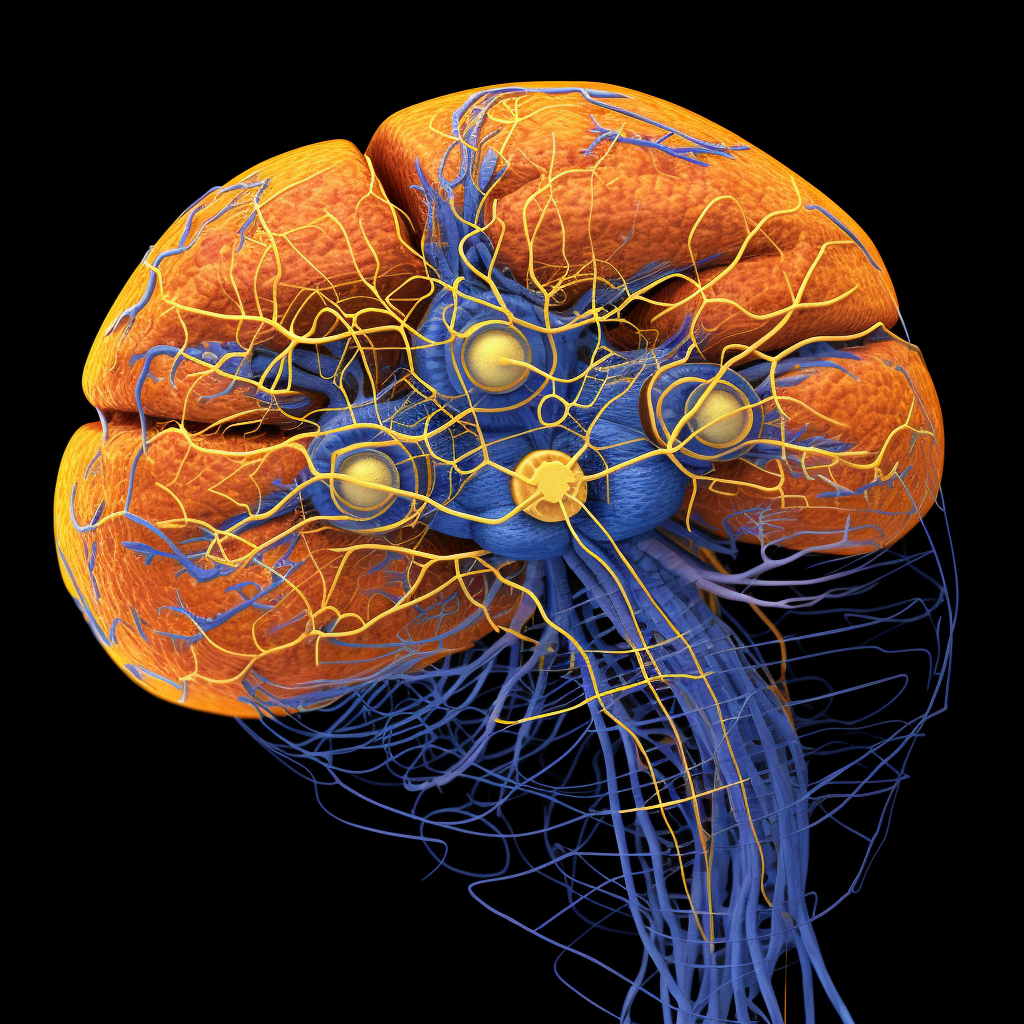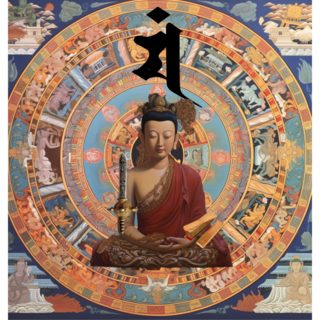ヒトを天才にする求聞持聡明法
求間持聡明法は、ヒトを聡明にし、天才にするという真言密教に伝わる秘法である。
弘法大師空海が、若くしてこれを修し、大天才となったということで、夙に知られてい
る。また、新義真言宗の開祖、興教大師覚鏝(一〇九五1一一四二)が、七度、この法を
修して成功せず、八度目に悉地を成じ、成功したと伝えられる。覚鏝上人ののこされた業
績をみれば、上人もまた天才でめったことは疑いない。ただ残念なことに、四十八歳で亡
くりれている。
真言密教の求聞持聡明法には、三種の法がある。
虚空蔵求聞持
観音求聞持
如意輪求聞持
であるが、ふつう、求間持法といえば、空海が修して有名な虚空蔵求間持をさす。この
つぶさ ぶつせつこくうぞうほさつのうまんしよがんさいしようしんだら・にぐもんじほう
法を、具には「仏説虚空蔵菩薩能満諸願最勝心陀羅尼求聞持法」という。
しかし、わたくしがこのたびこの本で発表する求聞持聡明法は、これらのいずれでもない。わたくしが独白に創成した求聞持法で、わたくしはこれに、だとによい
駄都如意求聞持聡明法と名づけた。
この駄都如意求聞持聡明法は、真言密教につたわる求聞持法とはまったくちがうものである。
二つの特徴がある。
それは、
一、クンダリニー・ヨーガのチャクラを覚醒して、超人的千不ルギーを発生させる。
二、その超人的干1 ルギーを、中国・道教につたわる導引・気功の持つ生気ルートに
のせて、体の各要所、要部にめぐらせ、行きわたらせる。殊に、大脳の中枢である間脳・視床下部に送りこむ。
この二つの方法を、独特の方法で完成したのである。これは、前人未踏の領域であるといってよいであろう。わたくしは、半生を、というより、一生をこの法の完成に注いだ。いまから約二〇年前に発行した『変身の原理』以来、わたくしの著書はこの本で四〇冊になるが、それらの著書のすべてが、この法の完成に至る道のりをあらわしたものであるといってよい。
わたくしは、この本で、わたくしの得たほとんどのものを、出来るかぎり、明らかにした。クンダリュー・ヨーガも、道教の導引・気功も、いずれも超人的能力を獲得するための
最高の法である。この世界にこれ以上の超能力開発法ぱない。この二つの法の欠陥を補正して融合させ、さらにあらたな創案をくわえて完成したこの駄都如意求聞持聡明法は、ヒ
トにおける究極の超能力開発法であると自負するのである。
もちろん、。後世おそる、べし”という諺の通り、今後、これ以上の超能力開発法も出るかも知れないが、しかし、それも、クンダリュー・ヨーガと導引・気功を融合させたこの駄
都如意求間持聡明法のライン以外のものではないであろうと確信している。
この法を、指導通りに修行するならば、確実に、ヒトの知能は二倍に、体力は三倍に飛躍強化されるであろうことを断言する。
天才は不老長寿でなければならない
求聞持聡明法は、たしかにヒトを天才にする。
しかし、いくら天才になっても、そのために、病弱になったり、若死にしたりしたのでは、なんにもならない。天才は、いつまでも若々しく、健康で、世のため、人のため、その才能を発揮するもの
でなくてはならない。(寝たっきりの天才など、まっぴらである)
求聞持聡明法修得をこころざしたわたくしは、つねに、四十八歳という惜しむべき短命に終わった興教大師党員上人が念頭にあった。上人は、おそらく、過酷な求間持法修行のため、法は成就したものの、体を痛め、寿命を損じたのにちがいなかった。
このことは、年少、結核を病んで何年も病床に伏した苦しい経験を持つわたくしにとり、その恐れの念が特に深刻であった。
しかし、この憂慮は、幸いにして杷憂におわった。
道教の導引・気功の秘法をとり入れたことが、この心配を吹きとばしてくれたのである。
すなわち、道教の導引・気功は、仙道の流れを汲むものである。そして仙道の理想は、不老長寿、生きながら神仙に化することを目標とする。
駄都如意求聞持聡明法は、特に不老長寿を目ざすものではなかったのだが、結果はそうなってしまったのである。
期せずして、仙道の理想が実現されることになったのだ。
神仙に化することだけはちょっとむずかしいが、不老長寿はかならず達成される。 わたくしぱ断言してよい。仙選の秘法がとり入れられているこの駄都如意求聞持聡明法
は、二十歳代の人ならば、三歳から五歳、中年以上の人ならば、十歳から十五歳、若返ることができるであろう。
あなたが高年者として修行に入り、年齢のために天才になれなかったとしても、いつまでも若々しい肉体と、そして決してボヶることのない求聞持脳だけは獲得できるであろう。
『求聞持聡明法秘伝』平河出版社刊。まえがき”より
「等価変換展開理論」
そんなことがほんとうにできるのか? いったいどうやってそんなことができるのだ、と。
それもたしかにもっともなことで、私自身、身をもってこの密教の秘密に挑戦し、自分でこの
技術を解明するまでは、ぜったいに信ずることができなかった。私は単身、五〇〇〇年の間秘密
のヴェールにつっまれてきたこの不思議な技術にいどみ、その秘密を解いた。それは、信ずるこ
とのできないほど精緻微妙な生化学に立脚したおどろくべき技術の応用であった。
たとえば、
さきにもちょっとふれたが、市川亀久弥博士は、最近の著作のなかマ(≒柚計器)お得意の
「等価変換展開理論」にもとづき、イモ虫からサナギヘの変化を例にして未来社会への脱皮を説
いておられる。この理論はまことにみごとで、まさにほれぼれするほどあざやかである。こと
に、イモ虫がサナギに変身する理論的うらづけは、近来しきりに輩出する未来論のなかで、まさ
に出 色のものであるというべきである。
ただ、まことに残念なことに、それは理論と説明と期待にとどまり、それをいかにヒトに応用
して実現させるかという方法を示していない。それは、もちろん、氏自身、同書のはしがきのな
かで、これは、″単に人類のあるべき未来社会に関するソフトーウェアの主張の範囲にとどまる
ものである”とことわり、この。ソフトーウェアに対するハードーウェアの具体的な提唱″は
″旺い将七に公長する~定である″ということであるから、われわれはまさに刮目してそれを待、ぐに、その″ソフトーウにアに対するハード・
ウェアの具体的な技術″を持っているのである。密教は、その持つ技術のひとつに、この市川理
論の「イモ虫からサナギヘの脱皮」技術を持っていて、数千年も前から、それをヒトの変身技術
に応用、実践していたのである。
密教は、現代の創造理論の大家が提唱する未来に関する花形理論を、とうに実践していたので
ある。五〇〇〇年も前にI。
地を這いまわることしか知らぬ生物であるイモ虫が、サナギになり、そして、空を舞う生物に
変身することは、二次元の世界に生きる生物が三次元生物に変化したことを意味するものだ。密
教がおなじ技術をもってヒトを変身させることは、三次元生物であるヒトをそれより上の次元に
飛躍させることを意味する。密教の変身技術はそれなのである。その生物の次元を変えてしまう
のだ。
しかも、それは、今までいわれてきたように、ただ神秘的、神がかり的なアイマイな方法でな
く、適確な生化学の技術をもっておこなうのだ。そうしてそれは密教の持ついくつかの技術のな
かのひとつに過ぎない。
いったい、どんな智恵がそれをなしとげていたというのであろうか? 密教の技術を神秘とい
うのなら、その点をこそ神秘というべきだろう。しかし、それは、それこそまさに数千年生え出
現した超・ヒトが、孤独にたえつつ、その持つ人類最高の智恵「照明智」を駆使してつくり上げ
た未来人のためのカリキュラムにほかならぬのだというよりはかないであろう。
さて、それでは、密教の技術に関係のある市川理論「等価変換展開理論」とはどんな理論か?
それがどのように密教の技術と関連があるのか?
それを説くまえに、もう少し知っておいていただかねばならぬことがある。
ここで、私は、密教とヨーガという二つのことばについて述べておかねばならぬと思うのだ。
拙著「変身の原理」で、私は、密教についてっぎのように述べた。少し長いが引用してみる。
『真言宗という宗派仏教と、密教すなわち秘密仏教とは、ふかいつながりかおる。だが、それは
どこまでもふかいつながりという関係であって、普通考えられているように、密教即真言宗、真
言宗即密教というものではないのである。
真言宗とは、インドにおいて発生し、大成した密教を、ああいう独白の形に体系化し、組織化
したものであって、密教そのものではないのである。密教のひとつの体系ではあるけれども、密
教そのものではない。
それは、それまでにほぼ完成していたけれども、分派し、多様化していたインド密教を日本密
教の開祖空海が、独自の見識と叡智によって、ひとつの体系につくりあげたということである。
おなじように、天台宗においても、天台密教というひとつの密教体系を組織完成しており、こ
れもまた、密教のひとつの流れということである。
そういうわけで、密教というものを正しく理解するためには、どうしても、]度、密教の原点
に立ちもどって考えてみなければならないのである。
密教は、最初、ひとつの手法(技術)であった。
けっして、最初から密教というひとつの宗教があったわけではない。
ゴータマーブッダがあらわれて、仏教というあたらしい教えを説きはじめるはるか以前、バラ
モンの時代から、インドには、入に超能力をあたえるひとつの手法があった。そういう手法が完
成されて、一部の人たちの間につたえられていた。それは、精神と肉体のきびしい錬磨から得ら
れる神秘的な力で、彼らは、それを、ひとつの技術にまでっくりあげていた。
われわれは、その流れのひとつを、現在、ヨーガのなかに見ることができる。(ただしそれは、
いまの日本で行なわれているアクロバティックな体操のヨーガではない。ヒマラヤの奥地の聖者
たちの間に伝承されている正統ヨーガである)
ヨーガは、その手法のひとつの流れである。この超能力を開発する技術は、仏教があらわれる
以前においてはバラモンにとり入れられ、仏教があらわれると、仏教もまたこれをとり入れた。
ゴータマーブッダは、かれ自身、この手法をまなんで、これにより超能力を持ったが、弟子た
ちにはこれを学ぶことを禁じた。なぜかというと、この技法によって多少の力がつくと、かれら
はすぐにそれがブッダのいう「ホトケ」という境地に達したものと考えてしまい、修行のさまた
げになるからであった。
ただし一部の、素質のきわめてすぐれた弟子たちには、ひそかにこれを許した。
ゴータマーブッダは、普通、神秘的な力を信じたり、修行者がそういう力を持つことを願った
りするのを全く禁じたというように、仏教学者や仏教者は信じているようであるが、それは間違
いで、ブッダ自身、神足({乱石の教理、すなわち、仏道を完全に成就するためには超自然的な
力が必要であるとし、超人間的な能力開発の訓練法を説いているのである。これは、パーリ文献
によって容易に証明することができるのである。(略)
それによると、それは、″四神足“または、″四如意足″ともいわれる超能力開発法である。
ブッダは、菩提を成就するためには、単に、知性や理性をみがくだけでは不十分であると考
え、知性や理性の限界をうち破る力が必要であると考えた。
そのために、彼は、そういう力を開発するための行法をつくりあげた。それは、彼が学んだ超
能力開発法を加えて編成したものと見てよいであろう。
それは、三十七種の技法から成り立つもので、四神足というのは、その中心になる技術であ
る。神通、如意を得るための定を、四種類の手法に分けて説明している。
欲神足(願望、理想、創造のためのアプローチ)
勤神足(体と心のトレーニング法)
心神足(潜在意識のトレーニング法)
観神足(深層意識のトレーニング法)
きづまりを打破するために、大乗仏教のなかにとり入れられて体系化され、密教と呼ばれになったのである。いうわけで、密教は二つの面を持っている。
一つは、超能力の開発技術
一つは、大乗仏教の教義
この二つである。
この二つのものがむすばれることにより、大乗仏教よりさらに高度の教義が完成されて、「金
剛大乗」と呼ばれる新しい仏教が誕生した。これが密教である』
-との引用の文章でわかるように、「変身の原理Lにおいて語られている「密教」というコ
トバは、「秘密仏教」という意味での「密教」である。仏教のなかにとり入れられた、いわゆる
真言密教、あるいは真言宗密教の密教である。
しかし、本書において私がいう「密教」は、それらの密教、「変身の原理」のなかで使われて
いる密教とは全くちがうものであることを、読者はご承知ありたいのである。
本書における「密教」とは、真言密教以前、いうならば仏教にとり入れられる以前の、いや、
バラモンにさえもとり入れられる以前の、引用文でいえば4 R教は最初、ひとつの手法(技術)であった。ゴータマーブッダがあらわれて、仏教というあたらしい教えを説きはじめるはる
か以前、バラモン時代から、インドには、入に超能力をあたえるひとつの手法があった。そういう手法が完成されて、一部の人たちの間につたえられていた。それは、精神と肉体のきびしい錬磨から得られる神秘的な力で、彼らは、それを、ひとつの技術にまでっくりあげていた。と
あるその「技術」、つまり、いうならば、″古代マーガ″と″真言密教″と、この二つを結合したものであると承知していただきたいのである。即ち本書でいう密教とは、ヨーガと真言密教と、
この二つをむすびつけて生まれた新しい技術であるということである。
なぜ、そういうことをしなければならなかったのか、というその理由を語ることはそのまま、密教の法を解説することにもなるので、読者はここのところをよく知っておいていただきたいのである。
引用文のなかにしるされているごとく、行きづまった大乗仏教は、ヨーガの技術にその打開の道を求めた。さきの頃で述べたごとく、精神の高度の飛躍は、その前提に、感覚器官の高度の増幅がなければならぬ。しかし、大乗仏教には教えだけあって、なんの技術もない。大乗仏教という教えであり、教えをあきらかにするだけのもので、技術というべきものはなんにもない。つい
に行きづまることは当然であり、やがてヨーガの技術に救いをもとめるのはさらに当然というべ
きことであった。
かくして、金剛大乗、真言密教が生まれた。ヨーガには、さきにあげた通り、ジョルジューオリヴィエ教授の表現を借りていえば、五つの能力開発技術がある。それは、①第四次元の理解、合複雑な全体をとっさに把握する能力、③第六感の獲得、④無限に発展した道徳意識、⑤とくに
われわれの悟性には不可解な精神的特質、というものであるが、これらの能力開発の技術は、それがそのまま大乗仏教にとり入れられたわけではない。おのずから、ひとつの偏向傾斜があった。
それは当然のことで、大乗仏教の指導者たちは、この技術を彼らの信奉する仏教教義とその目的に沿って取り入れた。一般的でないと思われる技術は捨てられ、あるいはごく一部の指導者にだけつたえられ、あるいは変形された。こうして秘密仏教というあたらしい教義と体系が完成した。しかし、多くのすぐれた開発技術は、この仏教教義を完成させるための補助的技術に変容さ
せられてしまった。あるいは形骸だけがとどめられた。これが、秘密仏教の「行法」であった。
これを究極的に完成したのは、日本密教、すなわち真言宗の開祖空海であった。秘密仏教がインドから中国につたえられ、そのころ中国にわたった空海がそれに接した時点において、秘密仏教はまだ完全にはできあかっていなかった。その混沌たる素材を取捨選択して、これをいま見る
真言宗というかたちにまとめ上げ、整然たる宗教にしたのは空海であった。それはまさに大天才のみがなしとげることのできる偉業であったが、同時に、秘密仏教はあまりにも整然と様式化された日本的なものになってしまった。それまでかなり残っていた密教的な部分はほとんどかげにかくれ、一-法」は、様式化された宗教儀式になってしまった。
しかし、それは、当時の目本の国情や、文化水準を背景にしたとき、やむを得ないことであったのである。というよりもむしろ当然であったというべきだろう。そうしなければ宗教として存
立することができなかったのである。
だが、そのために、いまいった通り「法」はその力を失った。宗教的に様式化され、儀式化されてしまった「法」では、真の能力開発は困難である。というよりもそれは絶望に近い しかし、それはそれでいいのだ。真言密教というものが、宗教であって能力関発の技術ではな
く、仏教という信仰のワクのなかで教えを説き礼拝をつづけているだけでよいなら、それはそれでいいだろう。それに、ほとんど儀式化された「法」であっても、天分のある才能が懸命の努力を集中するなら、「法」の成就も不可能ではない。やってやれないことはないのである。けれども、それは何世紀にひとりというような稀有の才能を必要とするのではないのか。そういうすぐれた頭脳によれば、様式化された法のあとをたどって、ついにその源泉に到達し、そのなかに秘められた法の技術を発見し、体得することもできよう。あるいはまた、頭脳ではなく、熱烈な信仰が、そこへ導いていってくれることもあるかも知れぬ。だが、それは、万人に期待できることではない。
要するに、真言密教成立の当時と全く時代が変ってしまった現在、真言密教が、他の宗教と根本的にちがうその本来の任務をほんとうに果たそうと思うならば、真言密教は大吝く変わらねばならぬ。真言密教はナみやかにその原点に立ちもどり、「法」を技術としてシステム化しなければならぬ。そうして、だれでもが平易にまなべる体系を編成ナることである。
それは決して「法」を解体し、「法」を壊滅してしまうことではない。むしろ、そうすることによって法が生きるのである。また、それは決して宗教の解体ではない。
法によって高い知的能力を得たならば、人はおのずから高い道徳意識、倫理観を持つものである。
人が宗教的教えを必要とナるのは、知的能力が低いからである。要するに、愚かだからである。人の道徳意識が低いのは、知能、精神能力が低いからだ。ほんとうに知能が高くなれば、人は、いま人類の持っている程度の宗教意識などけるかに超えたもっと高い倫理観を持つ。オリヴイエ教授のいう「無限に発展した道徳意識の保有」である。
教え(宗教)による人類の道徳意識の開発は、すでに限界に達してしまっている。
見よ。
地上にあまねくくりひろげられている人類のこの大愚行を。殺し合い、奪い合い、罵り合い。
どこに「知恵あるヒト」のおもかげがあるか? 「大愚人類」そのものではないか?
要するに、バカにいくら結構な教えを説いてもだめなのだということだ。
もっと忌憚なくいわしてもらうならば、(これは私がいうのではない。みんな密教の神サマが
おっしやるのであります)ちっとましなバカが、しょうのないバカに一心に教えを説いているというのが、いまの宗教のすがたというものではないのか?
宗教だけではない。科学と技術だってそうではないか。見さかいなくいい気になっていろんなものをつくり出し、あとで公害だ有害物質だと困っている。こういうおろかなことは、もう少し人類の知能が高くなったら、そんなバカなことはたのまれなくともしなくなる。要するに知能が低いからだ。
政治も、経済、思想も、みんなそうだと、あなたは真実思わないか?
要するに、すべて、″ヒトの知能が低い″ことに原因があるのである。
この世界を住みよく、たのしいものにするのには、革命ごっこよりもなによりもまず、ヒトの知能を高めることだ。そう、あなたは思わないか?
さて、話をもとにもどそう。
教えの限界とはヒトの知能の限界だ。
密教はその限界をうち破るのである。
技術によって超能力をあたえ、いっきょにヒトを改造して、宗教などという低い次元をいっぺんに飛び越し、想像を絶する叡智を持った、高い倫理的生物をつくり出そうというのだ。
それが、密教だ。
求闘持法《明星》の秘密
私はこのことを念力の護摩の修得に際してさとった。
先年、私は、念力の護摩法の伝授を受け、悉地成就の修行に入った。けれども、その行法の次
第を、何十ぺん何百。へんくり返しても、念力の火は出なかった。煙さえたちのぼる気配はなかっ
た。私かそのままその法の次第を忠実にくりかえしていたら、永久に念力の火は出なかったであ
ろう。出るはずがないのである。念力の護摩法の次第を、いくらくりかえしたって火は出ない。
そんなことで出るのだったら、今日までに、何百人、何千人の阿闇梨が念力の護摩を焚いていた
だろう。真言密教の念力の護摩法だけでは、ぜったいに火は出ない、それは、密教の技術によっ
て、サマーナ気を克服したとき(274頁参照)、はじめて肉体から火焔を発することができ、念力の
護摩は完成するのである。絶望した私は真言密教をはなれ、身を転じて古代インドの秘密経典に
むかった。
私はそこでインドの聖典、バガヴァットーギータを続み、そこに念力の護摩の秘法がかたられ
ていることを知った(口絵写真参照)。そこから、ギータと不二の関係にあるヨーガに入った。ヨ
ーガに本当の念力の護摩があることを知った。ヨーガにおける私のいのちがけの修行がはじまっ
た。ヨーガの技術でなければ念力の火は出ないことがわかったからである。真言密教の念力の護摩法次第は、ほんの心おぼえ程度のものに過ぎず、これでは、だれがどうしたって火の出るはずがなかった。いや、この肉体が火となるための「法」としては心おぼえ程度のものですらなく、むしろ、バガヴァツトーギータの聖句のほうが、はるかに示唆に富んでいるといえた。ヨーガの念力の護摩は、ただ単なる観想の羅列ではなく、どの生理器官をどのように統御しどのように動かすという現実的具体的な「技術」があった。この技術によってトレーニングすれば、多少なりと素質のある者だったら、必死の修行によって念力の火を出すことは不可能ではない。真言密教の念力護摩法次第だけでは、大天才といえども不可能にちかい難事である。この秘密を知らずして、古来、いく人の密教修行者が、念力の護摩の次第と秘伝を前に、血と汗の絶望をくりかえしたことであったろう。思えばツミな″次第″である。
これと全くおなじことが、真言密教につたえる「求聞持聡明法」についてもいうことができる。求闘持とは、古書に、『見聞覚知のことを憶持して長く忘れず、師なくして天地の感応を待つ、これを″求″といい、教なくして真如妙理を覚る。これを″聞″といい、一度覚るとながく忘れない、
これを″持″という』とあるように、求闘持法とは、ヒトの大脳を強化して、博覧強
卸、比類なき記憶力と聡明さをあたえる秘法であるが、これをなん十。へんなん百ぺん行法の次第通りに修行したところで、その結果は、おそらく念力の護摩とたいしてかわらない結果におわるであろう。生命を賭して修法すれば、多少の効果はあろうが、宗祖が体験を以て示したような霊験を得ることはまず難い。なぜならば、真言密教の「虚空蔵菩薩求聞持法」には印信観想による
精神集中の「法」はあるけれども、現実に生理器官である大脳皮質そのものを動かす「技術」を持っていないのである。ヨーガの「聡明法」は、どの器官をどう使ってどのように大脳皮質を動かすかという「技術」がある。また、それだけではない。根本的にちがうものがあるのである。
’それは、まったく根本的にちがう。
拙著「変身の原理」で求闘持聡明法についてかたって以来、私は、十指を越える真言僧侶、阿閉梨がたから、手紙あるいは直接、この法の修行について相談をうけた。そのほとんどは、自分も一度ないし数度にわたって求聞持法を修したが、いっさい効験がみられなかった。修法の行じかた、あるいは心構えに越法のところがあったのであろうかというのであった。また、何度か修してみて、あの行法にそんな神秘的な力がひそんでいようとは思われぬというものがあった。なかにはお気の毒にも健康を害してしまって、再起不能になったと訴えてきた阿閉梨もおられた。
お気の毒であるが、当然なのである。
真言密教の阿開梨がたが、いくら求闘持法をくりかえしても、成就できないのは当然なのである。もちろん、絶対に、とはいわない。万人に秀いでる天才、英才であったら、その極に達することができるかも知れぬ。しかしまず、不可能にちかいというべきだろう。
私か発見した密教の「求闘持法」でなければ、まず不可能にちかいといってよいであろう。こ
の法については章をあらためてくわしく書くが、ここで、求聞持法の秘密の一端を明かそう。まず、最初、真言密教の求聞持法を述べてみる。
『比の法を修するには、東南西三方の晴れたるところを最上とする。東方のみでも悪くはない。
道場の東壁に小窓をつくる。これは虚空蔵の似沢である明星の光を道場にさし入れるためである。また、朝日夕月の光を本尊にあてる意もあり、あるいは小窓に絹を張り、黄色の種字の字を書いて、そこから、明星の光をとおして本尊にあてるためでもある』
とまず場所を制定し、つぎに、さだめられた本尊の印明を百万べん、五十目あるいは百日に読誦するのであるが、日蝕または月蝕の時に結願するよう開白(はじめること)しなければならぬとある。
けれども、密教の求聞持法では、べつに場所はえらばぬのである。静かな場所でありさえすればよい。また、いつはじめてもよいのである。明星を拝するのも、行のはじめに際して、あるひととき、星と月に対すればよいのである。
また、これこそが密教のもっとも奥義とするところなのだが、弘法大師空海は、求聞持法の成就の体験を、
『―阿国大滝の岳にのぼりよじ、土州室戸の崎に勤念ナ。谷響を惜しまず、明星来影す。
言々』
と語っている。すなわち、阿波の大滝にのぼり、土佐の室戸岬でこの法の修行にはげんだところ、谷はこだまし、明星があらわれるなど、法にいわれている通り現証があり、法が成就した、
というのであるが、これは、空海のひとつの表現であって、これをそのまま鵜呑みにしてしまうからいけないのである。これはどこまでもひとつの表現なのだ。
伝にいわく、
『明星来影す、とは、結願のときに、香に火を置き、明星を拝するに、四方が暗く明星が見えねば悉地就成ではない。暗くても星が現ずれば下品の成就であり、四方が少々晴れて星が現ずれば中品、天に暗なく、ことごとく晴れて星現ずれば成就、四方が晴れても星現ぜざれば悉地成せざるなり』
とあるが、これがちがうのである。まるっきりちがう。
こういう口伝や奥伝をたよりにいくら修行しても、気の毒だが、求聞持法は成就しない。
明星とは現実の明星ではないのである。
大脳のある部分をある方法で刺激すると、目の前に光が見えるのである。
その光は、かたちも色も大きさも、いろいろに見えるが、意識を記憶の座に向けて沈静させる
と、つめたい、やや黄色みを帯びた白銀色になって、しずかに目のなかでまたたく。それはちょうど明星そっくりに見えるのである。
これが明星なのだ!
268頁をもう一度、読みかえしていただこう。
″頭のかかの光明に日を向けるならば″
とある。これがそれなのである。
ある特殊なトレーニングにより、この部位(大脳の視床下部のあたり)の刺激が、目のなかに光を浮かばせるのである。目をある角度に向けると、目を開けていても閉じていても、ポッカリと光が浮かんで見える。
この光が見えるようになると、記憶の座が自由にあやっれるようになるばかりでなく、さまざまな、奇蹟としか思えぬような力がついてくる。
これが、「求聞持法」の明星の秘密である。大空を百年ながめて空中の明星を見つめていても、ムダだ。明星はわが大脳のなかにあるのだからI。
このことは、密教五〇〇〇年の歴史に、私がはじめてっかんだ秘密である。私以外にこれを知る者はついになかった。求闘持法の秘密を私はついにつかんだ。私はそれを誇りに思う。
これをもとにして、私は、私の「求闘持聡明法」を編成した。これは、今までの「法」などというアイマイなものではない。生化学と生理学をもとにした「技術」である。正しい指導のもとに訓練を積めば、必ず、だれでもできるようになる技術である。
本来ならば、こういうことは私の、「太極秘伝」として、ごくかぎられた者だけにひそかにつたえてゆくべきものなのだろう。だが、私はこれをひろく公開する。なぜならば、私は、世界中の人びとがこの法によって知能を高め、いっさいの愚行-殺し合い、奪い合い、罵り合い、にくみ合いから遠ざかってほしいのである。
求聞持聡明法は、人の知能を三倍にナる。
しかし、その半分でもよい。人類の知能が今の水準より平均一・五倍飛躍したら、この世
から、犯罪も戦争もいっさいなくなる。そういうものがあるのは、人間が愚かだからだ。求闘持法によって知能指数が倍加したら、そういうものがいかに愚かで馬鹿々々しいことか、大人が子
供のヶンカが馬鹿々々しくて見ていられないように、いっさい、しなくなる。
私や、私の周囲のごく一部の者が、この法によっていくら賢くなろうとも、それがなにになろう。世界の大勢にどれはどの影響があろう。よしんば、私か、この法によって、古今無比の大聖者と仰がれるほどの力を持とうとも、世界のどこかで、権力を握っている馬鹿が、核バクダンのボタンをひとつ押したら、それっきりなのである。世界中はふっ飛んでしまう、古今無比の大聖
者もいっしよに!
まあ、古今無比の大聖者ともなれば、事前にそれくらい察知して、安全な所に待避してしまうであろうが、世界中が壊滅して、助かった者も核の灰に汚染されて半死半生ばかりという世のなかに、自分とごく少数の一族だけが生き残ってなにになろう。ノアの方舟の時とは状況が全くちがうのである。
このままでゆけば、核戦争がはじまるのはぜったい確実である。私にははっきりそれがわかる。この大愚行だけはやめさせなければならぬ。
革命よりも、階級闘争よりも、人種闘争よりも、なによりも、いま、人類に必要なのはこれだ。これが根本的に人類を救う道だ、とそう私は思う。ヒトの知能が二倍になったら、いま、人類がかかえているあらゆる問題はすべて解決してしまう。そう、あなたも思わないか?
私か、この求聞持法を惜しげもなく公開し、ひとりでも多く、一目でも早く、修得してほしいとねがうのは、そのためなのだ。
さて、はなしが少々よこにそれたが、この大脳の部位のことは、インドのヨーガの指導者も知っており、ヨーガのほうでは、この部位のことを、
「頭のなかの光座の座」
とか、
「梵の座、梵の裂け目」(brahma randhro
とか、
「サハスララーチャクラ」
と名づけ、頭の中の光明がかがやいている部分であると考えている。しかし、これも解釈がちがっている。
頭のなかに光明がかがやいているのではない。私の発見した求闘持法とおなじ原理である。大脳のある部位を、あるエネルギーで刺激すると、あるひとつの物質が分泌され、それが脳の神経組織を刺激して、目に光を感じさせる。 『- それが、頭と目の微妙な角度のちがい、刺激の相違で、目のなか、目の前、および、頭のなか、というように、光の浮かぶ場所がちがうのである。
求聞特法の湯合は、目の前の、やや上方、ニメートルから三メートルくらいのところに浮かんでみえる。目の角度と、瞳孔の絞りかたによっては、はるか遠くの空に小さくかがやくように
(ちょうど明星のように)見えないこともない。もし、人里はなれた山のなかであったら、明けの明星のように見えることもできるだろう。私の経験では、目のななめ上方一メートル内外のところに見えるようにするのが、一番、″上品″のようである。
目を閉じて、目の奥の上方、つまり、ヨーガでいう”梵の座”のあたりに、光明を感じさせる
技術は、頭の角度と、脳の刺激する揚所が、求聞特法と少しちがう。したがって、これは、求聞持法ではなく、ちがう力を発現する。また別な法である。この法については、またあとで別に章をもうけて説明しよう。
(サマーナ気統御の技術》と《護摩法》の合体
おなじような例がいくっもある。
たとえば″五相成身観”である。
これは、真言宗徒がかならずおさめねばならぬ金剛界法という法のなかにあり、密教門でもと
くに重要な観法とされる行法である。
凡夫がホトヶという超能力者になるまでの過程を五つに分け、修行者は、ひとつひとつその境界を体験してゆくのであるが、これが、いずれも密教の重要な修行課目になっており、あきらか
に密教から出たものであることがわかる。
しかも、真言密教では、印と観想の二つからなる”観法″であるが、密教においては、観法だ
けではなく、特殊な技術による鍛 練によって生理的器官を動かし、実際に五つの境界に対応す
る力をつける訓練となっている。
また、真言密教においてもっとも重要とされる金剛界九会マンダラもそうである。金剛界九会
マンダラは、凡夫がホトケになる九つの段階と、ホトケというものの力、ホトケのはたらきを図
像にえがきあらわしたものであるが、要するに、ホトケの説明である。
もっとも、真言密教は、このマンダラにもとづいて、前記した金剛界法という行法を編成し、
。観法″によってこれを修行者に体得させようとする。これは、一般仏教、顕教が、その修行方
法として、ただ、経典の読誦と、念仏、唱名題目しか持だないのに対し、一段と進歩したすぐれ
た修行方法であるというべきだが、しかし、これも、真言密教が″観法”だけであるのに対し、
密教は、九会マンダラにあらわされた九つの力を実際に体得させる訓練技術を持っている。
例をあげれば、微細会マンダラがそうである。これは九会マンダラのなかの東南方に位するマ
ンダラで、ホトケの微妙幽玄にして不可思議なる智恵の力とはたらきをあらわすものである。
密教には、実際にこの力を生ぜしめる訓練がある。
真言密教では、ただ、。観想″による″観法″しかない。現実にそういう″力″を持たせると
ころの″技術″がない。
276頁を見ていただこう。
。あきらかに、微細会マンダラは、ヨーガのこの訓練から出ている。ナくなくとも、この訓練に
よって得られる力を背景にしたものであることは間違いない。
これは、密教の技術で、胸の部分の或る部位に力を集中することによって得られる力である。
-こうしてみてくると、真言密教がとるべき道は、おのずから明らかであるといわねばなるまい。真言密教の行法は、密教の技法をとり入れることにより、本当の力が生ずるのではないのか?
そういうと、密教がそんなにすぐれたものであるというなら、密教は真言密教をはなれて、密教独自の道を歩んだらよいではないかという意見が出るかも知れない。その通りである。それでもよいのだ。そういう道もあると私も思う。
しかし、それにもかかわらず、私か真言密教にある価値を見出すのは、その表現様式である。おもしろいことだと思う。
様式だけになってしまっている(と私が思う)真言密教の、その様式が、なかなか貴重なのだ。
私が体得した密教の秘奥の技術を、さて、どのように表現しようかと、その様式を考えてゆくと、結局、真言密教の様式がいちばん便利なのである。たとえば、私の体得創案した「求聞持法」は、ヨーガの技術から発見したもので、真言密教の「求聞持法」とは全然ちがう。そのことは、前の項でおわかりになったことと思う。

